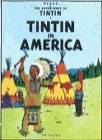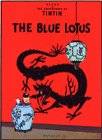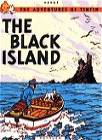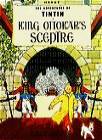 |


 |  |
 |
 Tintin in the Congo
Tintin in the Congo
Following his Russian adventure, Tintin is sent to the Congo, which was a huge Belgian colony at that time. A chain of events leads
him to the kingdom of the Babaoro'm where he gets the title of sorcerer. The circumstances find him obligated to confront a bunch of Al
Capone's Gangsters, who want to rule over the production of diamonds in the Congo. Of course, he manages to arrest them and leave the Congo shortly there after, telling us his future destination: America.
The first black & white version was published in 1931. The album was drawn again in color in 1946. Hergé took advantage to cut out
some details with too much of a colonialistic twist. However, this album was in a period of disgrace for a long time, and it was only circa 1970 to find it more often in the bookstores.
Arabic: ? - Basque: Tintin Kongon - Brazilian: Tintim na Africa - Catalan: Tintín al Congo - Danish: Tintin i Congo - Dutch: Kuifje in Afrika - Farsi: Tantan dar congo - Finnish: Tintti Afrikassa - French: Tintin au Congo - Galician: Tintín no Congo - German: Tim in Kongo - Greek: Ο ΤΕΝΤΕΝ
ΣΤΟ ΚΟΝΓΚΟ - Hebrew: Tintin Be' Congo - Icelandic: Tinni i Kongó - Italian: Tintin in Congo - Norwegian: Tintin i Kongo - Portuguese: Tintim no Congo - Spanish: Tintín en el Congo - Swedish: Tintin i Kongo - Turkish: Tenten Kongo'da
|
|
|
 |
 |  |
 |
 Tintin in America
Tintin in America
After the Congo experience, Hergé sends his hero to America. As soon as he arrives in Chicago, he is kidnapped by Al Capone's gangsters who find him too dangerous. After successfully arresting them, he goes after Boby Smiles, the chief of a rival gang. Tracking him down, he ends up in the hands of the ''Red Skins" set against him by Boby Smiles. Always a winner, Tintin apprehends the criminal and goes back to Chicago. One more time, he has to battle more criminals but only to enhance his triumph. He leaves the country after a very much American style parade through the streets.
Tintin in America was published in black and white in 1932 and drawn again in color in 1945. When the time came to publish it in the USA in 1973, the publishers forced Hergé to eliminate certain "non conformist" parts: that's how some black people become either blurred or simply white, revealing the racist atmosphere still prevaling in United States at that time...
Arabic: Tantan wa `assâbât chîkâghû - Basque: Tintin Ameriketan - Bengali: Americai Tintin - Brazilian: Tintim na América - Catalan: Tintín a Amèrica - Chinese: Ding Ding Zai Mei Zhou - Danish: Tintin i Amerika - Dutch: Kuifje in Amerika - Farsi: Tantan dar Amrica - Finnish: Tintti Amerikassa - French: Tintin en Amérique - Galician: Tintín en América - German: Tim in Amerika - Greek: Ο ΤΕΝ
ΤΕΝ ΣΤΗΝ
ΑΜΕΡΙΚΗ - Hebrew: Tintin Be' America - Icelandic: Tinni i Ameriku - Indonesian: Tintin di Amerika - Italian: Tintin in America - Norwegian: Tintin i Amerika - Portuguese: Tintim na América - Spanish: Tintín en América - Swedish: Tintin i Amerika - Turkish: Tenten Amerika'da
|
|
|
 |
 |  |
 |
 Cigars of the Pharaoh
Cigars of the Pharaoh
Tintin is on a cruise bound for the Far East. He meets on board an eccentric Egyptologist named Sophocles Sarcophagus in search of Kih-Oskh's tomb. Tintin agrees to join him. Tintin discovers in the tomb some mysterious cigars and is kidnapped. Left alone to drift at sea, he's nevertheless saved and lands safely in Arabia. From there, after many an adventure, he ends up in India in the house of Maharajah Rawajputalah. He then takes it on himself to fight the opium trade and manages to dismantel Rastatopoulos gang. By the end he discovers that the cigars were filled with the opium he was after.
The first version of Cigars of the Pharaoh was published in 1934. The color version however did not come out until 1955, which is 9 years after the color version of The Blue Lotus. Except for a few scenes that were cut-off, and the modified set, both versions are very similar.
Afrikaans: Die Farao se Sigare - Basque: Faraoiaren Zigarroak - Bengali: Faraoer Churut - Bernese: Em Pharao siner Cigare - Brazilian: Os Charutos do Faraó - Breton: Segalennoù ar Faraon - Catalan: Els cigars del faraó - Danish: Faraos cigarer - Dutch: De sigaren van de farao - Farsi: Cigarhaye Pheroan - Finnish: Faaraon sikarit - French: Les Cigares du pharaon - Galician: Os xarutos do Faraón - German: Die Zigarren des Pharaos - Greek: ΤΑ
ΠΟΥΡΑ ΤΟΥ
ΦΑΡΑΩ
- Hebrew: Ha'sigarim Shel Ha'paronim - Icelandic: Vindlar Faraos - Indonesian: Cerutu sang Faraoh - Italian: I sigari del faraone - Japanese: Pharaoh no Hamaki - Korean: ? - Latin: De sigaris pharaonis - Luxembourger: Dem Pharao Séng Zigaren - Norwegian: Faraos sigarer - Portuguese: Os Charutos do Faraó - Serbo-croat: Faraonova cigara - Spanish: Los cigarros del Faraón - Swedish: Faraos cigarrer - Turkish: Firavunun Purolari
|
|
|
 |
 |  |
 |
 The Blue Lotus
The Blue Lotus
Without being a real sequel to Cigars of the Pharaoh, The Blue Lotus is complementary to that book. A messenger from China coming to meet Tintin in Rawajputalah is hit by a dart dipped in Rajaijah, the poison of madness. He only has time to pronounce the word Mitsurirato. Tintin leaves to meet him and is victim of some botched attempts on his life. Being convinced to go back to India, he is taken away by Wang Chen-Yee, an old man fighting the opium trade. After a sabotage, Japan invades China and Tintin is caught in the middle of the conflict. Meanwhile, he saves the life of Chang Chong Chen, a young Chinese who befriends him.
Finally he succeeds in stopping once and for all Rastatopoulos gang, to cure Wang's son of his madness and to have Wang adopt Chang. It's with tears that Tintin leaves them for Europe.
Published in 1936, The Blue Lotus is without a doubt Tintin's book that's closest to real historical events of its time. As a matter of fact, Hergé makes mention of the Japanese invasion, changing only but a few names. It's also the first book showing a real concern for realism. Hergé received some help from the real Chang Chong Chen who came to him as a young art student. A deep friendship developed between the two men, and Herge included him in his story.The color version is from 1946.
Arabic: Zahra allûtus al-zraqâ' - Basque: Loto Urdina - Bernese: Die Blau Lotos - Brazilian: O Loto Azul - Breton: Al Lotuz glas - Catalan: El lotus blau - Danish: Den Blå lotus - Dutch: De blauwe lotus - Finnish: Sininen Lootus - French: Le Lotus bleu - Galician: O Loto Azul - German: Der Blaue Lotos - Greek: Ο
ΜΠΛΕ ΛΩΤΟΣ - Hebrew: Ha'Lotus Ha'kachol - Icelandic: Blai Lotusinn - Indonesian: Lotus Biru - Italian: Il drago blu - Japanese: Aoi Hasu - Korean: ? - Luxembourger: De Bloe Lotus - Norwegian: Den Blå Lotus - Farsi: Gol e abee - Portuguese: O Lótus Azul - Serbo-croat: Plavi lotos - Spanish: El Loto Azul - Swedish: Blå Lotus - Turkish: Mavi Lotus
|
|
|
 |
 |  |
 |
 The Broken Ear
The Broken Ear
An Arumbaya fetish was stolen from the ethnographic museum: Tintin decides to find out why. Following the leads, he encounters two men interested in the same fetish. These men leave for the South American Republic of San Theodoros, Tintin tracks them down there and ends up in the midst of a revolution. Just by chance, he becomes General Alcazar's chief of staff. Then a war erupts between San Theodoros and the neighboring Nuevo Rico. Wanted by all, Tintin escapes to the land of the Arumbayas. That's where he discovers the secret of the fetish, which contains a precious diamond. It's finally back in Europe that he will find the fetish again and he will return it to the museum.
This Tintin's adventure first came out in 1937 and the color version in 1943. Once again, Hergé makes several allusions to world news facts.The San Theodoros VS Nuevo Rico war is a transposition of the Gran Chaco oil-war between Paraguay and Bolivia in the '30s.
Arabic: Tantan wa al-'audhun al-maksûratu - Basque: Belarri Hautsia - Bengali: Kanbhanga Murti - Brazilian: O Idolo Roubado - Breton: Ar Skouarn dorr - Catalan: L'orella escapçada - Danish: Det knuste øre - Dutch: Het gebroken oor - Farsi: Goosh e shekaste - Finnish: Särkynyt korva - French: L'Oreille cassée - Galician: A orella rota - German: Der Arumbaya Fetisch - Greek: ΤΟ
ΣΠΑΣΜΕΝΟ ΑΥΤΙ - Hebrew: Ha'ozen Ha'shvurah - Icelandic: Skurdgod med skard i eyra - Indonesian: Patung kuping belah - Italian: L'orecchio spezzato - Japanese: Kowareta Mimi - Luxembourger: D'Ouer mam Krack -Norwegian: Det knuste øret - Occitan: L'Orelha copada* - Portuguese: A Orelha Quebrada - Russian: Сломанное ухо* - Spanish: La oreja rota - Swedish: Det sönderslagna örat - Turkish: Kirik Kulak
* Quoted but not published
|
|
|
 |
 |  |
 |
 The Black Island
The Black Island
Tintin is being shot at trying to help out a plane in difficulty. He takes it upon himself to track down his assaillants in England. The
evidence leads him to a named Dr. Muller. After succeeding to escape from him, Tintin follows him to Scotland. He traces him to the Black Island, famous for being the abode of the "Beast". Tintin goes there anyway and discovers the gang's headquater: Muller and his colleagues are money-forgers. Tintin manages to arrest them and to find out the real nature of the Beast, a gorilla.
The first version of The Black Island dates back to 1938, and it is in 1943 that the color edition came out. In 1965, Hergé had to redraw entirely this album to satisfy his English publishers who thought Great Britain was misrepresented. One may notice acertain imbalance between the modern drawings and a Tintin character which is still of the 30's...
Arabic: Tantan fî-l-jaza'îrati as-sûdâ' - Asturian: La Islla Prieta - Basque: Uharte beltza - Bengali: Krishnadwiper Rahasya - Brazilian: A Ilha Negra - Breton: An Enez du - Catalan: L'illa negra - Chinese: Hei dao - Danish: Den sorte ø - Dutch: De zwarte rotsen - Esperanto: La nigra Insulo - Farsi: Jazeereye Siyah - Finnish: Mustan saaren salaisuus - French: L'Île noire - Galician: A illa Negra - Gallo: Sus l'ile naire - German: Die Schwarze Insel - Greek: ΤΠ
ΜΑΥΡΟ ΝΗΣΙ - Hebrew: Ha'ee Ha'shachor - Icelandic: Svadilfor til Surtsey - Indonesian: Rahasia pulau hitam - Italian: L'isola nera - Japanese: Kuroi Shima no Himitsu - Latin: De insula nigra - Luxembourger: D'Schwaarz Insel - Malay: Pulau Hitam - Norwegian: Den sorte øya - Portuguese: A Ilha Negra - Romansch: L'Insla naira - Serbo-croat: Crno ostrvo - Spanish: La isla Negra - Swedish: Den svarta ön - Turkish: Kara Ada
|
|
|
 |
 |  |
 |
 King Ottokar's Sceptre
King Ottokar's Sceptre
Tintin meets Professor Alembick who must go to Syldavia, and Tintin accepts to join him as his secretary. He notices on the plane the strange behavior of the professor but he is ejected from the plane. Saved by a miracle, Tintin learns about a conspiracy against the king and goes to Klow to warn him. Someone is going to steal the sceptre that he is supposed to show the people on the day of Saint Vladimir in order to be able to reign. In spite of all the security measures, the theft occurs and Tintin has to investigate. He discovers the truth about this plot. Borduria, its neighbor ennemy country shall invade Syldavia after the chaos caused by the fall of the king. Tintin finds the sceptre and the Bordurian plan fails. The real Professor Alembick is freed and the king awards Tintin a medal.
Hergé confessed that King Ottokar's Sceptre is the story of a failed Anschluss. This was a hot news subect at the time, since the book was published in 1939 on the eve of World War II. The book was drawn in color in 1947 with the help of Edgar P. Jacobs. Hergé and his collaborator took advantage to give a Balkan style to the clothes and decors .
Arabic: Tantan wa-ssûljan al-malik ûtûkâr - Basque: Ottokarren zetroa - Brazilian: O Cetro de Otokar - Breton: Bazh-Roue Ottokar - Catalan: El ceptre d'Ottokar - Chinese: ? - Danish: Kong Ottokars scepter - Dutch: De scepter van Ottokar - Faroean: ? - Farsi: Assaye asrar ameez - Finnish: Kuningas Ottokarin valtikka - French: Le Sceptre d'Ottokar - Galician: O cetro de Ottokar - German: König Ottokars Zepter - Greek: ΤΟ
ΣΚΗΠΤΡΟ ΤΟΥ
ΟΤΤΟΚΑΡ - Hebrew: Sharvito shel Ha'melech Otokar - Icelandic: Veldissproti Ottokars konungs - Indonesian: Tongkat raja Ottokar - Italian: Lo scettro di Ottokar - Norwegian: Kong Ottokars septer - Occitan: Lo Scèptre d'Otocar* - Portuguese: O Ceptro de Ottokar - Russian: Скипетр Оттокара* - Serbo-croat: Skiptar kralja Otokara - Spanish: El cetro de Ottokar - Swedish: Kung Ottokars spira - Turkish: Ottokar'in Asasi - Welsh: ?
* Quoted but not published
|
|
|
 |

Next books...

 
|














